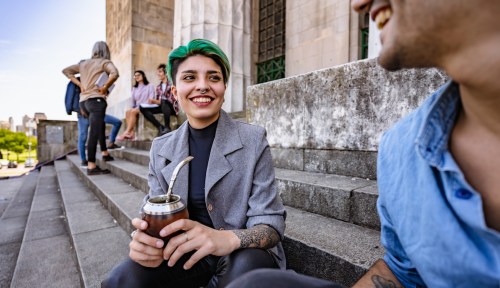7 Wellness Practices You May Not Have Known Came from Latin America
It's Latinx Heritage Month—to celebrate, we're noting wellness practices you probably didn't know came from Latin America.

Few non-Latinx people know that an array of wellness practices adopted by societies around the world (and sometimes still considered “alternative” medicine today) originated with the great civilizations of Latin America where they were very much the norm. Indigenous civilizations spanning what is now known as the Americas were herbal and animistic. From the Aztecs and Mayans to the Guaraní and Charrúa—groups of civilizations across the continent were intimately involved in natural healing and practices of shamanism.
As of 2011, the World Health Organization (WHO) determined that between 70 and 95 percent of citizens in a majority of global south countries, especially those in Latin America, rely on traditional herbal medicine as a method of primary health care. WHO defines traditional medicine as “the sum total of the knowledge, skills, and practices based on the theories, beliefs, and experiences Indigenous to different cultures, whether explicable or not, used in the maintenance of health, as well as in the prevention, diagnosis, improvement or treatment of physical and mental illnesses.”
A burgeoning interest in cultural roots has helped Latinx shed the colonial violence that demonized their ancestors’ traditional knowledge. Latinx are reclaiming lineal wellness practices leading to community-wide ancestral healing. These are seven wellness traditions that came from Latin America.
1. Sage Smudging
One of the most popularly commodified wellness traditions, the practice of burning sage, originated in Latin America and has been adapted (and mostly culturally appropriated) around the world. Some Mesoamerican Indigenous populations use sage for purification rituals to banish dark energy. Smudging with sage has become so popular around the world that the plant is over-harvested, making it challenging for Indigenous people who use sage for sacred practices to access the plant.
2. Burning Palo Santo
Over-harvesting also threatens Palo Santo, which translates to “the wood of saints” in Spanish, because of its immense global popularity, making it difficult for Indigenous populations in the Amazons to obtain the wood. Amazonian tribes traditionally cultivate the wood for ancestral ceremonies.
Much of the Palo Santo that’s sold today wasn’t properly removed from the forest. Shamans in the Amazon don’t collect the wood until the tree has died naturally, as it’s the tree’s spirit that lends healing to humans when it’s burned.
3. Yerba Mate
The root of Yerba Mate herbal tea dates back to pre-Columbian Paraguay where it was originally consumed by the Indigenous Guaraní people for medicinal purposes. Yerba Mate is high in antioxidants, caffeine, and anti-inflammatory properties. The plant was consumed across the Río de la Plata and is still popular today to drink in the traditional fashion in Uruguay, Argentina, Paraguay, and parts of Chile and Brazil.
The culturally correct way to drink Yerba Mate is from a gourd through a perforated straw known as a bombilla. While Brazil remains the primary producer of Yerba Mate, the drink has been whitewashed and is often consumed in a bottled form in Germany.
4. Cacao Ceremonies
Cacao is the tree fruit native to Latin America used to make chocolate, but it also has spiritual importance to many Indigenous groups in the region. The plant was used as far back as 1,500 B.C.E by the Mesoamericans.
Chocolate was integral to the culture of the Mayans who reserved high-quality cacao for priests, while lower grade cacao was used as currency. Cacao was used during sacred ceremonies and also as a health elixir. The Aztecs believed cacao was an aphrodisiac which may be why it’s considered to be heart-opening and used in westernized cacao ceremonies today.
5. Plant-based Medicine
Most kitchen cupboards have spice racks filled with ingredients that have Latin American roots. Many of the herbs and spices were used in traditional medicine to support healing ailments. For instance, allspice was used by Mesoamericans for male infertility. Guava leaves were used to heal skin irritations, such as eczema. Yagruma leaves from trumpet trees were placed in baths for limpiezas to cleanse negative energies from the body, mind, and soul.
The bark of the Cinchona tree was used to treat malaria as it contains quinine. Europeans ‘discovery’ of quinine led to malaria drugs that have most likely saved the highest number of lives in history. Quinine remains the oldest antiplasmodial drug still in clinical use. The list of traditional plant-based medicines from Latin America is endless.
6. Birth Control
People who take the birth control pill can thank Uruguay and Mexico for the drug. The birth control pill is a form of wellness as it prevents unwanted pregnancy, thus empowering people to make their own choice regarding what to do with their bodies. Alejandro Zaffaroni was an Uruguayan on the team in Mexico that developed the birth control pill. The biochemist also played a significant role in the development of the nicotine patch, the DNA chip, and corticosteroids.
7. Worry Dolls—Or Sleeping With Dolls
It’s common for children to take ‘worry dolls’ to bed at night in Guatemala—especially when they’re scared. To ward off nightmares, Guatemalan kids are encouraged to whisper to the worry dolls about their fears and then lay them underneath their pillow before bedtime. This practice helps them have a good night’s rest and is a Mayan custom in the Guatemalan highlands. The dolls are believed to absorb worries, stress, and fear so that the children can dream sweetly.
Oh hi! You look like someone who loves free workouts, discounts for cutting-edge wellness brands, and exclusive Well+Good content. Sign up for Well+, our online community of wellness insiders, and unlock your rewards instantly.
Sign Up for Our Daily Newsletter
Get all the latest in wellness, trends, food, fitness, beauty, and more delivered right to your inbox.
Got it, you've been added to our email list.










